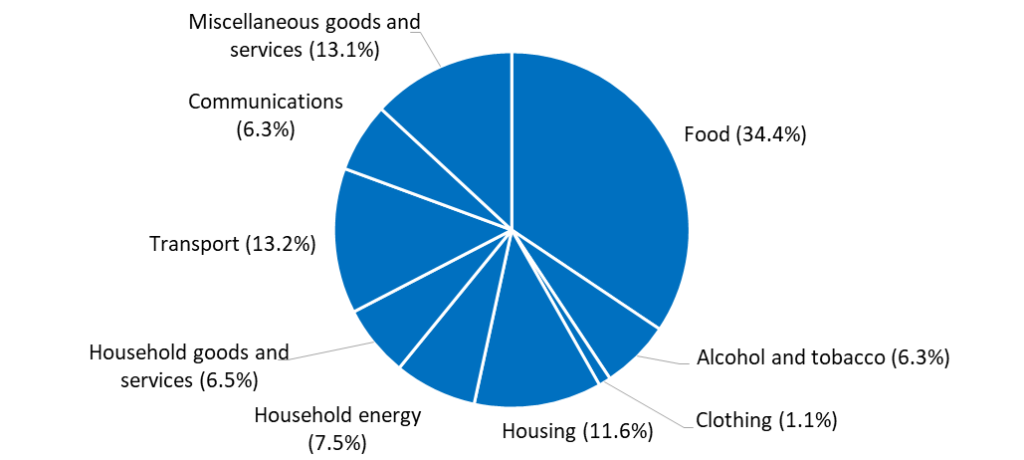22 April 2024
The Statistics Office has released new estimates of the Retail Price Index (RPI) and the annual inflation rate for Q1, 2024. The RPI is a statistical measure of the change in retail prices on St Helena; an increase in the RPI means that, on average, prices have gone up since the last time they were measured, and a decrease in the RPI means that, on average, prices have fallen. The annual change in the RPI is called the annual inflation rate, and is the usual measure of the change in prices in an economy. The RPI is an average measure: if it goes up, it does not mean that all prices have gone up, and similarly, if it goes down, it does not mean that all prices have fallen.
Latest RPI and annual inflation rates
For the first quarter of 2024, the RPI has been measured at 116.9; in Q1 2023 the RPI was 114.8, resulting in an annual inflation rate of 1.8%. This is 1.7 percentage points higher than the previous annual inflation rate for Q4 2023, which was 0.1%.
Price changes in the last year
The Retail Price Index uses 203 representative items to measure price changes in nine different major categories of household spending. Since a year ago, 92 items increased in price, 32 items decreased in price, and the price of 79 items remained unchanged. Recently, the RPI has been affected by a drop in the price of Communications in Q4 2023, due to changes in the broadband internet and mobile telephone tariffs; by changes in the price of Transport caused by fluctuations in the price of petrol and diesel; and, in Q1 2024, by changes to Household Energy caused by increases to the price of electricity which came into effect on 1 January 2024.
Pirce changes by category
Compared to a year ago, prices in most categories increased, especially in Clothing, Household Energy, and Housing. Household Energy and Housing were affected by price increases to the electricity and water tariffs introduced at the beginning of the year by the utility company, Connect St Helena Limited. Clothing prices often fluctuate because of relatively high stock turnover in outlets, but the category has a relatively small weight in the index. However in the overall average index many of these increases are partly offset by the drop in the price of broadband internet and mobile phone connections introduced by the telecommunications company (Sure), in October 2023.
Frequently Asked Questions
What is price inflation?
Price inflation is the change in the average prices of goods and services over time. The rate of price inflation is calculated from the change in the RPI, which is the official measure of the average change in the prices of goods and services paid by consumers. The RPI is estimated each quarter, i.e. once every three months, and the rate of price inflation is usually quoted on an annual basis; that is, comparing price changes over a 12-month period. Prices and the RPI tend to go up, but they can occasionally go down – which is known as price deflation.
Why do we measure inflation?
An accurate measure of price inflation helps understand the extent and nature of the impact of price changes on the government, businesses, households and individuals. Inflation rates are often used in budgeting and accounting processes so that costs can be adjusted for the effect of price changes.
How is the RPI calculated?
The basis for the RPI is the average weekly cost of goods and services purchased by households on St Helena, sometimes called the RPI ‘shopping basket’. Items which households purchase more of, such as food, have the biggest share of the RPI basket. The current RPI uses a basket from the latest Household Expenditure Survey in 2017; prices representing the groups of items in the basket are collected every quarter, and the price of the total basket is compared to the price in the baseline period, the first quarter of 2018. By convention, the value of the basket in the baseline period is scaled to 100, and the RPI values are quoted in relation to that baseline. For example, an RPI value of 120 means that average prices have increased by 20 per cent compared to those recorded in the baseline period.
Composition of average household weekly expenditure (Q1 2018 RPI ‘Shopping Basket’)

What happens when items are not available?
If an item of the ‘basket’ is not available then either the previous price will be carried forward from the previous quarter, or a suitable substitute item will be identified and an adjustment calculation made. Care is taken to ensure that this substitute item represents the item category and that it does not introduce error to the measurement of the RPI. An important principle is that price changes should reflect actual price increases and decreases, and not changes in the quality of items.
Where can I get the data?
For detailed tables of the RPI and annual inflation rates from 1994 onwards, please visit: https://www.sainthelena.gov.sh/st-helena/statistics/the-economy and download the ‘inflation’ data file. Other datasets, bulletins and reports are also available on our website: www.sainthelena.gov.sh/statistics.
Have more questions or comments?
Please get in touch. We are Neil Fantom, Statistical Commissioner, Kelly Clingham and Justine Joshua, Senior Statistical Assistants and Courtney O’Dean, Statistics Assistant. You can find us in person at the Statistics Office on the top floor of the Post Office, Jamestown. You can also contact us by telephone on our direct line through 22138. If calling from overseas, the international dialling code for St Helena is +290. Our general office e-mail address is statistics@sainthelena.gov.sh, or you can email team members directly (the format is firstname.lastname@sainthelena.gov.sh).